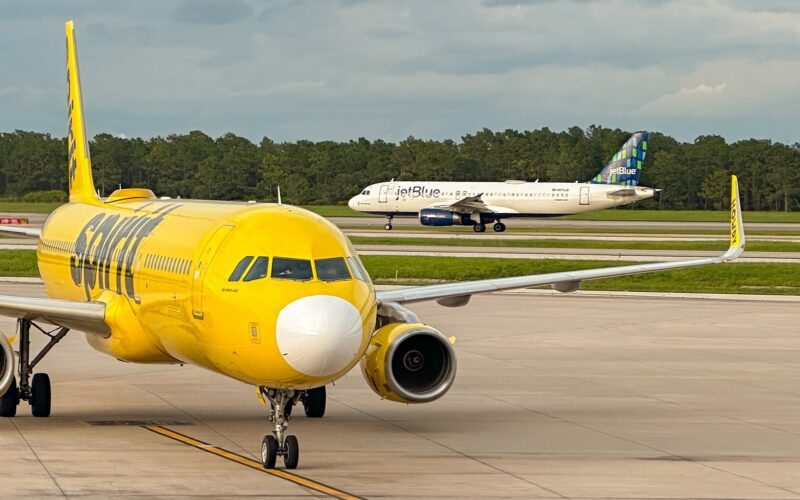JetBlue or Frontier Could Still Acquire Spirit Airlines — But the Odds Aren’t Great

Bankruptcy can sometimes breathe new life into old business plans — and that may be exactly what’s happening with Spirit Airlines. The ultra-low-cost carrier, famous for its bright yellow planes and no-frills approach, has entered its second Chapter 11 restructuring in a year, reopening conversations about potential mergers or acquisitions that once seemed impossible.
Just last year, Spirit’s proposed $3.8 billion merger with JetBlue Airways was blocked by the U.S. Department of Justice on antitrust grounds. Regulators argued the tie-up would reduce competition and raise fares in key markets, halting the deal in federal court. But with Spirit now on financially shaky ground, that option may be back in play.
Industry analysts have long viewed a merger or sale as Spirit’s best path forward. The airline has struggled to boost revenue faster than costs since the pandemic, facing higher fuel prices, stiff competition from larger carriers, and changing passenger preferences. Spirit’s attempts to merge with either Frontier Airlines or JetBlue since 2022 have all failed, but its latest bankruptcy could make it more open to negotiation — and more attractive to a buyer looking for market share and assets at a discount.
JetBlue: A Difficult but Possible Deal
For JetBlue, acquiring Spirit would offer access to valuable Airbus A320 series aircraft, routes, and crews that could strengthen its domestic network. However, the regulatory hurdles remain steep. The previous JetBlue-Spirit merger was blocked precisely because the government argued it would eliminate a major low-fare competitor.
Still, Spirit’s deteriorating finances could shift the calculus. A new JetBlue bid, if structured carefully, could include route divestitures, competition commitments, or joint-venture limitations to ease antitrust concerns. Spirit’s weakened position might also make regulators reconsider whether blocking a deal now would push an airline into collapse — ultimately harming, not helping, consumers.
In short, JetBlue’s acquisition is possible but difficult, requiring major concessions and a friendlier regulatory climate in Washington. Under current conditions, the probability sits around 20–30 percent.
Frontier: A More Natural Fit
Frontier Airlines, which operates under a similar ultra-low-cost model, could present a more logical and less controversial match. A Frontier-Spirit combination would likely draw less scrutiny than a merger between a budget carrier and a mid-tier airline like JetBlue.
Also, Frontier Airlines and Spirit Airlines operate essentially the same family of aircraft: the Airbus A320neo family, which includes the A319, A320, and A321 models.
However, Spirit has previously rejected multiple Frontier offers, citing insufficient valuation. For Frontier to succeed this time, it would need to improve its bid or wait until Spirit’s financial distress deepens enough to make a lower offer acceptable.
Still, the strategic logic is strong. A combined Frontier-Spirit airline could create a dominant ultra-low-cost competitor capable of pressuring major carriers while preserving the no-frills model for price-sensitive travelers. Frontier’s chance of success is moderate — roughly 30–40 percent, depending on financing, timing, and regulatory approval.
Consolidation Is the Name of the Game
If Spirit can exit bankruptcy through a merger, the no-frills airline model might survive to compete another decade against the legacy carriers. Right now, Spirit’s second restructuring is expected to leave it smaller, leaner, and potentially ripe for acquisition. JetBlue, meanwhile, is facing its own profitability challenges, while Frontier continues to navigate thin margins and intense competition.
Ironically, the government’s decision to block the earlier JetBlue-Spirit merger — citing concerns over reduced consumer choice — may have accelerated Spirit’s decline. Regulators failed to see that allowing two struggling disruptors to combine might have preserved, not diminished, competition against giants like Delta, United, and American. After Spirit’s latest bankruptcy announcement, United Airlines immediately launched fare promotions aimed at poaching Spirit’s customer base — a sign of how fragile the low-cost landscape has become.
Is the No-Frills Model Dead?
Spirit’s financial woes reflect a broader shift in consumer behavior. The ultra-low-cost model that once revolutionized air travel now appears to be losing traction. Travelers today are less willing to sacrifice comfort for minimal fares, and larger airlines have blurred the line by offering basic economy seats with low prices but more flexibility and optional upgrades.
A merger among low-cost carriers could give the budget segment new life. By combining forces, airlines like Spirit, JetBlue, and Frontier could retain the scale and efficiency needed to compete meaningfully in an evolving market. But continuing to battle one another for the same cost-sensitive passengers no longer makes sense.
Unless a major regulatory shift occurs or Spirit’s finances improve dramatically, an acquisition remains unlikely but not impossible. The market has changed — and unless low-cost airlines change with it, the concept that made them successful may not survive the decade.
Related News: https://airguide.info/?s=spirit+airlines, https://airguide.info/?s=jetblue, https://airguide.info/?s=frontier+airlines
Sources: AirGuide Business airguide.info, bing.com, yahoo.com, reuters.com
